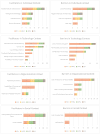Facilitator and Barrier to Health Information System Use from Health Professionals Perspective: A Scoping Review
- PMID: 40657566
- PMCID: PMC12248237
- DOI: 10.2147/JMDH.S515295
Facilitator and Barrier to Health Information System Use from Health Professionals Perspective: A Scoping Review
Abstract
Objective: This study aimed to present factors that potentially influenced system use by identifying facilitator or barrier to acceptance from the perspective of healthcare professionals.
Methods: A scoping review was used in line with the Preferred Reporting Items for Systematic Reviews and Meta-Analyses extension for Scoping Reviews (PRISMA-ScR) guidelines. The literature search was conducted on two electronic databases, Scopus and MEDLINE through PubMed, limiting the publication timeframe from January 2013 to December 2023. Moreover, a developed search strategy was used based on keywords and MeSH terms derived from the Population, Concept, and Context (PCC) components. The inclusion criteria were studies that discussed information system in healthcare, incorporated healthcare professionals who directly engaged with health information system (HIS), conducted within healthcare settings, identified facilitator or barrier to the use of information system in healthcare, and were available in full-text English. Barrier and facilitator were considered as factors impeding and promoting HIS use, respectively. The scoping review adopted a thematic analysis.
Results: The results showed that a total of 79 studies met the inclusion criteria and were included in this review. A total of 16 distinct facilitators and 16 barriers were identified, which were then grouped into four categories, comprising colleague and social support, organizational, individual, as well as technological and technical contexts. The most frequently mentioned facilitator was usefulness and simplification of daily tasks, while the predominant barrier was lack of technical support.
Conclusion: The systematic mapping of facilitator and barrier provided a foundation for policymakers and healthcare professionals in decision-making processes to enhance acceptance HIS.
Keywords: barrier; electronic health record; facilitator; health information system; health professionals.
© 2025 Yuliasih et al.
Conflict of interest statement
The authors declare that there are no conflicts of interest in this work.
Figures
Similar articles
-
Health professionals' experience of teamwork education in acute hospital settings: a systematic review of qualitative literature.JBI Database System Rev Implement Rep. 2016 Apr;14(4):96-137. doi: 10.11124/JBISRIR-2016-1843. JBI Database System Rev Implement Rep. 2016. PMID: 27532314
-
The effectiveness of using non-traditional teaching methods to prepare student health care professionals for the delivery of mental state examination: a systematic review.JBI Database System Rev Implement Rep. 2015 Aug 14;13(7):177-212. doi: 10.11124/jbisrir-2015-2263. JBI Database System Rev Implement Rep. 2015. PMID: 26455855
-
Cost-effectiveness of using prognostic information to select women with breast cancer for adjuvant systemic therapy.Health Technol Assess. 2006 Sep;10(34):iii-iv, ix-xi, 1-204. doi: 10.3310/hta10340. Health Technol Assess. 2006. PMID: 16959170
-
Understanding factors influencing the implementation of medicine risk communications by healthcare professionals in clinical practice: a systematic review using the Theoretical Domains Framework.Res Social Adm Pharm. 2024 Feb;20(2):86-98. doi: 10.1016/j.sapharm.2023.10.004. Epub 2023 Oct 18. Res Social Adm Pharm. 2024. PMID: 37978010
-
Community and hospital-based healthcare professionals perceptions of digital advance care planning for palliative and end-of-life care: a latent class analysis.Health Soc Care Deliv Res. 2025 Jun 25:1-22. doi: 10.3310/XCGE3294. Online ahead of print. Health Soc Care Deliv Res. 2025. PMID: 40580081
References
-
- Kreps GL. Online information and communication systems to enhance health outcomes through communication convergence: online health information and communication Systems. Hum Commun Res. 2017;43(4):518–530. doi: 10.1111/hcre.12117 - DOI
Publication types
LinkOut - more resources
Full Text Sources
Miscellaneous



